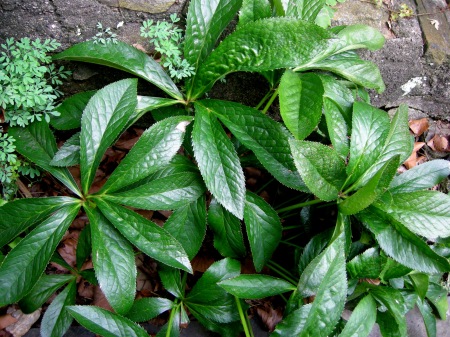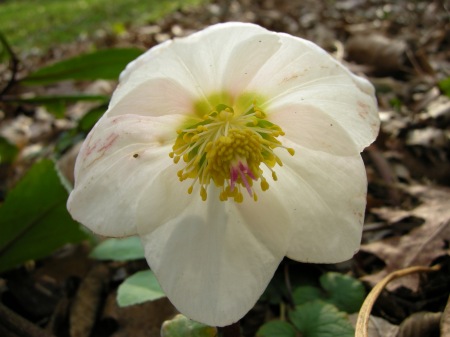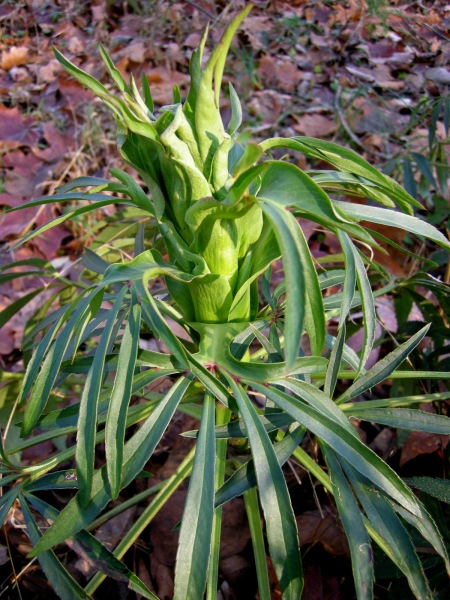 Tudor walled garden at Rothe House in Kilkenny, Ireland (courtesy of the Rothe House Museum website)
Tudor walled garden at Rothe House in Kilkenny, Ireland (courtesy of the Rothe House Museum website)
During our recent trip to Ireland, Michael and I visited the lovely and interesting town of Kilkenny, home to Ireland’s “Medieval Mile”. We were especially interested in seeing the Rothe House Museum and Garden but very much enjoyed the whole town. The Rothe House is actually three houses and three courtyards plus a large walled garden, all built between 1594 and 1610 by John Rothe Fitz Piers, a merchant, landowner, and Mayor of Kilkenny. He and his wife Rose Archer and their 12 children lived there until John’s death in 1620 when his oldest son Peter took over the business and property.
Nursery News: Carolyn’s Shade Gardens is a retail nursery located in Bryn Mawr, PA, specializing in showy, colorful, and unusual plants for shade. We are open from approximately December 15 to June 15. The only plants that we ship are snowdrops to US customers only. For catalogues and announcements of events, please send your full name, location, and cell number (for back up use only) to carolyn@carolynsshadegardens.com. Click here to get to the home page of our website for catalogues and information about our nursery and to subscribe to our blog.
 Street view of the Rothe House (courtesy of Ireland Dept. of Environment, Heritage, and Local Government)
Street view of the Rothe House (courtesy of Ireland Dept. of Environment, Heritage, and Local Government)
Between 2005 and 2007, the Kilkenny Archaeological Society, which owns the building complex, excavated the walled garden area, which runs from the back of the mansion on Parliament Street to the city wall. The excavations exposed the original layout of the very large Tudor era garden, including its planting beds, paths, walls, and even the seeds and pollen of the 17th century plants. Over 2,000 artifacts from the period were recovered. Based on these discoveries, the garden has been meticulously restored using plants from the 17th century.
.
 The entrance to the Rothe House walled garden is through this archway from an inner courtyard.
The entrance to the Rothe House walled garden is through this archway from an inner courtyard.
This garden is very large for an urban, walled garden. The lower garden near the house contains vegetables and herbs, while the upper garden is an orchard. It was pouring rain the day we were there—the only day it rained while we were in Ireland—which made it difficult to take photos. The weather was also not conducive to reading all the explanatory signs, which would have been very helpful when putting this post together. Nevertheless, I think you will enjoy seeing the garden, and I hope you will visit it if you are ever in Ireland.
.
 Looking back over the vegetable and herb garden towards the house.
Looking back over the vegetable and herb garden towards the house.
.
 Everything was very well maintained.
Everything was very well maintained.
.
 borage and other edible and medicinal plants including artichokes at the back right
borage and other edible and medicinal plants including artichokes at the back right
.
 As usual, I envy the delphiniums as it is too hot and humid to grow them in southeastern Pennsylvania.
As usual, I envy the delphiniums as it is too hot and humid to grow them in southeastern Pennsylvania.
.
 Another plant that grows much better in Ireland: Corsican hellebore. We can grow it in PA, but the leaves, which unlike hybrid hellebores have the flowers at the end of their stalks, always get ruined over the winter and look awful when the flowers open. I forgo the flowers, trim the plant to the ground, and enjoy the fresh leaves for the rest of the season.
Another plant that grows much better in Ireland: Corsican hellebore. We can grow it in PA, but the leaves, which unlike hybrid hellebores have the flowers at the end of their stalks, always get ruined over the winter and look awful when the flowers open. I forgo the flowers, trim the plant to the ground, and enjoy the fresh leaves for the rest of the season.
.
 Michael, bundled up against the rain, gives some perspective on the mammoth size that Corsican hellebores attain in the mild Irish climate.
Michael, bundled up against the rain, gives some perspective on the mammoth size that Corsican hellebores attain in the mild Irish climate.
.
 Luckily, hybrid hellebores do beautifully in Pennsylvania and in Ireland.
Luckily, hybrid hellebores do beautifully in Pennsylvania and in Ireland.
.
 Lupines don’t grow in the Pennsylvania heat and humidity either but were beautiful all over Ireland.
Lupines don’t grow in the Pennsylvania heat and humidity either but were beautiful all over Ireland.
.
 I have tried this Jacob’s ladder, Polemonium caeruleum, several times in my garden and see it for sale at many local nurseries in Pennsylvania. Again, it is unsuited to our climate—now I know where it does grow well. Luckily, native dwarf Jacob’s ladder, P. reptans, does beautifully in Pennsylvania.
I have tried this Jacob’s ladder, Polemonium caeruleum, several times in my garden and see it for sale at many local nurseries in Pennsylvania. Again, it is unsuited to our climate—now I know where it does grow well. Luckily, native dwarf Jacob’s ladder, P. reptans, does beautifully in Pennsylvania.
.
.
.
 A lovely meadow like area between the lower and upper garden.
A lovely meadow like area between the lower and upper garden.
.
 Looking from the lower garden into the orchard
Looking from the lower garden into the orchard
.
.
 Providing a home for orchard pollinators
Providing a home for orchard pollinators
.
.
Next up a Victorian walled garden at Kylemore Abbey.
Carolyn
.
Nursery Happenings: You can sign up to receive catalogues and emails about nursery events by sending your full name, location, and cell number (for back up contact use only) to carolyn@carolynsshadegardens.com. Subscribing to my blog does not sign you up to receive this information. Please indicate if you will be shopping at the nursery or are interested in mail order snowdrops only.
Carolyn’s Shade Gardens is a local retail nursery in Bryn Mawr, Pennsylvania, U.S., zone 6b/7a. The only plants that we mail order are snowdrops and only within the US.
Facebook: Carolyn’s Shade Gardens has a very active Facebook Page where I post single photos, garden tips, and other information that doesn’t fit into a blog post. You can look at my Facebook page here or click the Like button on my right sidebar here.
Notes: Every word that appears in orange on my blog is a link that you can click for more information. If you want to return to my blog’s homepage to access the sidebar information (catalogues, previous articles, etc.) or to subscribe to my blog, just click here.
























